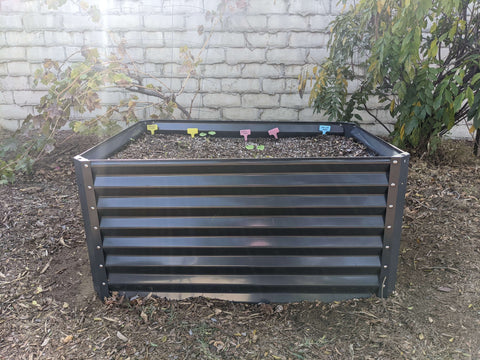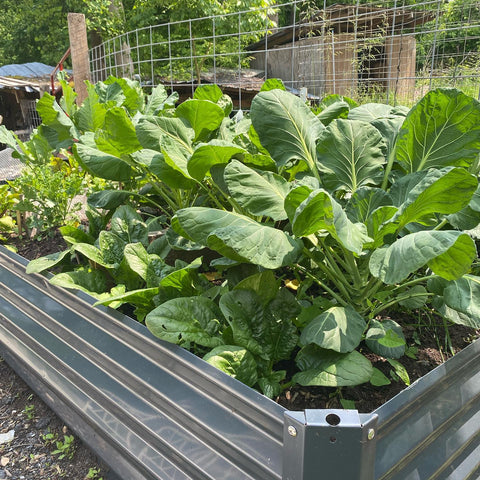Rock is a unique and durable material that can create stunning landscape features and structures for gardens. In flower bed design, the use of rock to build U-shaped garden flower beds is a popular choice, which not only provides beautiful boundaries and functional Spaces, but also shows the perfect fusion of nature and man made.The following content also has some reference value for raised garden beds.

Rock flower beds not only have a beautiful appearance, but also have many other advantages. The rock's sturdiness and durability make it a reliable choice that can stand the test of time and the natural environment. In addition, the natural texture and variety of the rocks allow you to create unique and admirable flower beds according to your personal preferences and design needs.
However, to successfully build a U-shaped garden bed using rocks requires some detailed planning and preparation. From choosing the right rock type and size, to layout design and plant selection, every step requires careful consideration and meticulous scheduling. In the following sections, we will explore in detail which areas to start with to ensure that you can effectively use rocks to create beautiful and functional U-shaped garden beds.
- Planning and design:
First, you need to plan and design the size and shape of the flower beds in your U-shaped garden. Take into account the available space and the function of the flower bed, determine the length, width and depth of the flower bed.
- Prepare tools and materials:
In order to create a U-shaped garden bed, you will need a number of tools and materials, including rocks (which can be natural or artificial), a level, a spade, a hammer, stakes, rope, sand, and plants.
- Mark boundaries:
Using stakes and rope, mark the boundaries of the U-shaped flower bed. Make sure the length, width, and shape of the border line match your design.
- Prepare the groundwork:
Clean and level the floor of the flower bed. According to the size of the flower bed, a trench was excavated parallel to the boundary line of the flower bed, and the depth was about half the height of the rock. Fill the bottom of the trench with a layer of sand to provide foundation support.
- Install rock:
The rocks are placed on the foundation and installed one by one according to the designed U-shaped boundary lines. Use a level to ensure that the rock is placed horizontally, and use a hammer to gently tap the rock so that it is firmly installed on the sand.
- Connecting rocks:
If needed, use special rock adhesives to join the rocks together for added stability and firmness. Follow the adhesive instructions and ensure that the adhesive is evenly applied to the rock contact surface.
- Fill the soil:
Fill the back of the rock with soil to fill the inside of the U-shaped flower bed. Make sure the soil is evenly filled and use a spade or shovel to lightly compact the soil to make it firm.
- Grow plants:
Choose plants suitable for U-shaped flower beds and plant in the soil as needed. Water according to plant requirements and carry out daily care and maintenance.
- Create multi-layered effects:
If you want the flower bed to have a multi-level effect, you can stack rocks inside the flower bed. Use larger rocks for the bottom layer and smaller rocks for the upper layer, and place appropriate soil fill between the different levels.
- Add edges:
To add beauty and structure to the flower bed, you can add a stone edge or border to the edge of the U-shaped flower bed. This can be individual rocks or specially designed garden edge materials to define and protect the boundary of the flower bed.
- Consider water discharge:
Make sure there is a good water drainage system around the flower bed to prevent water buildup and damage to the rock structure. Set up appropriate drains or pipes around the flower bed to direct excess water to the appropriate drainage area.

- Perform regular maintenance:
Once the U-shaped garden bed has been constructed, it is essential to perform regular maintenance. Remove weeds and fallen leaves from the flower beds, and trim plants regularly to keep the beds clean and beautiful. Check that the rock is stable and repair or replace it if necessary.
- Consider safety:
Always be safe when using rocks to build flower beds. Make sure the rock is securely installed to prevent it from collapsing or falling apart. If the rocks are heavy or require the use of high places such as ladders, follow the correct safety procedures and have experienced personnel assist with the job.
- Consider landscape characteristics:
The natural beauty of the rock is used to enhance the landscape effect of the flower bed. Depending on the location of the flower bed and the overall landscape design, choose rocks that are in harmony with the surrounding environment and style. Rocks of different colors and textures can be selected to create a visually appealing and contrasting effect.
- Create touch and height variation:
Use rock shape and size differences to create tactile and height variations within the flower bed. Use the larger rock as a prominent feature or central focus, then use smaller rocks around it to fill in the gaps. This creates a rich variety of visuals and dynamics.
- Consider additional elements:
In addition to the rocks themselves, you can also consider adding other additional elements to the flower bed to add interest and personality. For example, you can install a small waterfall, pool, or fountain to add to the water feature. You can also use rocks to build paths, steps, or seats for a better view of the flower beds.
- Consider plant options:
Choose suitable plants according to the location of the flower bed, light conditions and climate characteristics. Consider the plant's height, color, and growth habits to create an aesthetically balanced combination of plants. Leave enough space between the rocks to accommodate the roots of the plant and ensure that the plant is grown and cared for to meet its specific needs.
- Consider water conservation and drainage:
When designing and building flower beds, it is important to consider water conservation and good drainage. Choose plants that are drought tolerant and adapted to the local climate to reduce watering needs. Make sure the flowerbeds are well drained to avoid water buildup and excessive soaking of plant roots.
- Extensions and modifications:
Over time, you may want to extend or modify the U-shaped garden bed. Allow some leeway in the design and construction process for future adjustments and improvements. Leave enough room to add new rocks, plants, or other decorative elements, and make sure that any modifications are made with the original flower beds
- Consider seasonal changes:
When designing the flower bed, it is necessary to take into account the changes of different seasons and the growth cycle of the plant. Choose plants with different seasonal flowering periods to ensure that the flower beds maintain a beautiful and diverse landscape throughout the year. In addition, seasonal plants are changed regularly to suit the colors and atmosphere of the different seasons.
- Consider eco-friendliness:
There are a few eco-friendly practices to consider when creating a U-shaped garden bed. For example, rainwater harvesting systems are used to collect rainwater, which is then used to water plants to reduce water consumption. Choose native plant varieties that are better adapted to local climate conditions and reduce the need for pesticides and fertilizers.
- Pay attention to balance and proportion:
When arranging rocks and plants, pay attention to the principles of balance and proportion. Make sure the size and number of rocks match the size of the flower bed to avoid an overly crowded or sparse layout. At the same time, the height and volume of the plants should be coordinated with the rocks to create an overall harmonious landscape effect.

- Lighting Design:
If you plan to enjoy the flower beds at night, consider adding an appropriate lighting design. Use low-light outdoor fixtures or solar lamps to illuminate flower beds and highlight the beauty of rocks and plants. Make sure the lighting is positioned and angled to effectively illuminate the flower beds and create a warm nighttime atmosphere.
- Consider sustainability:
Sustainable materials and methods can be considered when building U-shaped garden beds. For example, choose rock materials from renewable resources, or use recycled rock products. Avoid using chemicals that are harmful to the environment or dispose of waste from flower beds in the right way.
- Maintain beautification and maintenance:
In order to maintain the beauty of the U-shaped flower beds, regular maintenance is essential. Keep flower beds clean and organized by trimming plants, weeding, and cleaning debris and dirt from rock surfaces. Check the stability of the rock regularly and repair any damaged or loose parts promptly.
- Seek professional advice:
If you are unsure or inexperienced about the process of using rocks to build a U-shaped garden bed, it is wise to seek professional advice. Work with a landscape architect, horticultural expert or stonecutter who can provide expert guidance and advice to ensure your flower bed is designed and built to best practice and safety standards.
- Consider your surroundings:
When building a U-shaped garden bed, consider the compatibility of the bed with the surrounding environment. Look at the surrounding buildings, vegetation and natural elements and choose colors and styles of rocks and plants that complement their surroundings to create an overall harmonious landscape effect.
- Budget planning:
It's important to have a clear budget plan before you start building. Factor in the cost of things like rocks, tools, materials, and plants, and set aside some extra budget to cover unexpected costs that may arise. This will help you control the cost of the flower bed construction process and ensure that you are able to complete the project within budget.
- Learn and explore:
Building a flower bed is a creative process, and constantly learning and exploring new techniques and ideas can enhance your design and construction capabilities. Reading relevant gardening magazines, visiting garden shows, or interacting with other garden enthusiasts are all great ways to gain inspiration and knowledge. Expand your horizons and bring more possibilities to your flower bed design.
- Patience and enjoyment:
Last but not least, enjoy the whole building process and be patient. Rock building a flower bed is a process that requires patience and effort, but the end result will bring you satisfaction and joy. Share your flowerbed construction process with family and friends, and proudly admire and enjoy the fruits of your labor when the flowerbed is completed.

Whether as a unique landscape feature or to provide space to grow plants, using rocks to build U-shaped garden beds can add natural beauty and structure to your garden. Ensure that the proper planning, preparation and implementation steps are followed, and that adjustments are made to your personal preferences and circumstances at any time.









